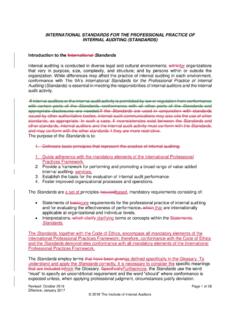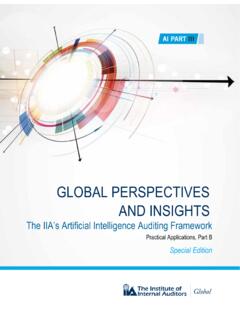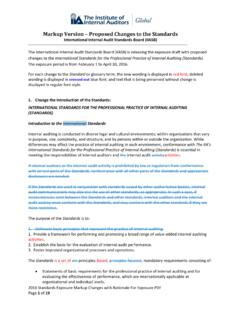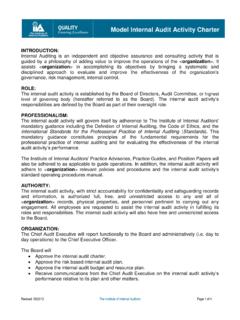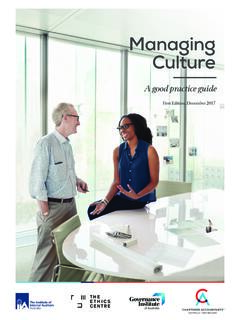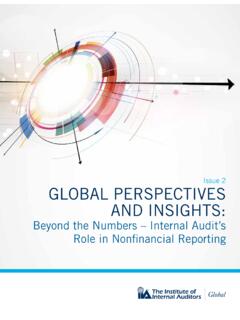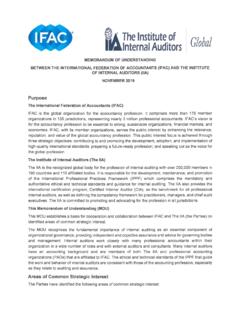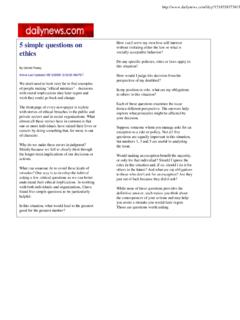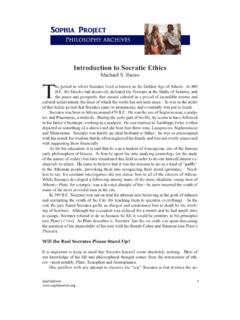Transcription of Survey on Ethics and Governance A Research Project
1 2006 The IIA Research Foundation Survey on Ethics and Governance A Research Project The Institute of Internal Auditors Austin Chapter 2005-2006 Research Project March 29, 2006 Chapter Research Committee: Robert W. Cates, CIA David J. MacCabe, CIA, CGAP, MPA Beverly H. Williams, CIA 2 2006 The IIA Research Foundation INTRODUCTION The Institute of Internal Auditors Austin Chapter Research Committee recently conducted a Survey of 55 chief audit executives (CAEs) who are members of the IIA Austin Chapter and/or the Texas State Agency Internal Audit Forum to obtain ideas on auditing Ethics and Governance in keeping with IIA Performance Standard 2130.
2 Only the CAE (or designee) or the senior auditor within each organization was asked to respond to the Survey to ensure that only one response was received from each chapter member organization. The Survey was administered on-line through SurveyMonkey, and the web link to the Survey was sent via email to each member organizations CAE. The Survey questions were a combination of 24 yes/no, multiple-choice and open-ended type questions. The open-ended questions were used primarily to gather additional information or clarification pertaining to the other questions.
3 The Survey summary indicates that not all of the respondents answered every question . Respondents had the option of identifying their organization on the last question ; otherwise, the respondents organization remained unnamed. The purpose of the Survey was to identify the role that Internal Audit plays within the Ethics and Governance structure of the organization, and to obtain ideas on how internal auditors can help create an awareness of the Ethics and Governance concepts within their organization. The Survey consists of four sections: Organizational Demographics, Policy and Procedures, Executive Management, and Internal Audit.
4 The content of this report is a summary of the information gathered through the Survey . ORGANIZATIONAL DEMOGRAPHICS The questionnaire was sent to 55 CAEs within the Austin Chapter and/or the Texas State Agency Internal Audit Forum. Forty-one useable responses were received, a 75% response rate. In the first section of the Survey , the respondents were asked to identify their organizations industry type and the size of their organization -- by number of employees and by annual revenue (or budget). Industry Type The five industry types consisted of federal/state government, city/county government, education, private sector, and not-for-profit.
5 Seventy-one percent of Survey respondents were from the government sector -- either federal, state, county or city. The education segment accounted for 17%, private sector accounted for 10%, and not-for-profit accounted for the remaining 2%. Size of Organization Respondents were asked to assess their organization size by the number of employees and by their annual revenue or budget. The results are illustrated in Tables 1 and 2 below. 3 2006 The IIA Research Foundation Table 1 Number of Employees Response Total Percent Less than 100 1 100 to 500 12 501 to 1,000 6 1,001 to 5,000 11 More than 5,000 11 Table 2 Annual Revenue or Budget Response Total Percent Under $10 million 3 $10 million to $25 million 2 $26 million to $100 million 9 22% $101 million to $500 million 9 22% $501 million to $1 billion 7 More than $1 billion 11 POLICIES AND PROCEDURES Survey questions four through twelve relate to the organizations Ethics and Governance policies and the key features; and communication efforts utilized within the organization.
6 Ethics and Governance Policy While 93% of the organizations do have an Ethics policy, only 38% report having a Governance policy. Further, only 35% of the organizations have both an Ethics and a Governance policy. An additional three respondents indicated that while their organization does not have a specific Ethics policy, the employee code of conduct does address ethical standards. The Survey provided respondents an opportunity to share some of the key features of their organizations Ethics and Governance policies. Most policies address the common elements such as confidentiality; conflict of interest; fraud/waste prevention/detection; use of company/state property; nepotism; standards of performance and professionalism; acceptance of benefits, gifts and favors; and outside employment.
7 Communicating the Policies Although establishing policies within an organization is important, equally important is how the policies are communicated throughout the organization. Therefore, the respondents were asked to indicate the methods used by their organization to communicate the Ethics and/or Governance 4 2006 The IIA Research Foundation policies to the employees. The most common methods of communication include a combination of the following: management meetings (71%), email messages (61%), training sessions (66%), and other (42%). The other methods of communication included the use of new employee orientation, annual acknowledgment, newsletter, intranet, video, and/or the organizations general manual.
8 Perceived Gap or Not? Another interesting question is whether the CAE perceives a gap between the organizations Ethics and standards and the way the policies are administered -- 89% answered no perceived gap. However, the remaining 11% indicated that a gap does exist. Ethics Advisor, their Job Title, and Ethics Hotline Service Available Of the 30 organizations with an in-house Ethics advisor, 66% of the advisors retain the job title of Attorney, 6% the Human Resources Manager, and the remaining 28% reported Other ( Ethics Officer, Ombudsman, Corporate Compliance Office, or Executive Manager). Additionally, 66% of respondents said that their organization has some type of Ethics or fraud hotline service available.
9 EXECUTIVE MANAGEMENT The third section of the Survey focused on executive managements role related to Ethics and Governance . Respondents were then asked to whom the CEO reports, how frequently executive management speaks about Ethics and Governance in management meetings, and whether the organization uses outside speakers to provide training about Ethics and Governance . Survey responses are illustrated in Tables 3 through 5 below. Table 3 To Whom Does Your CEO Report? Response Percent Taxpayers/Citizens Board or Commission Governor Owners/Shareholders Other 5 2006 The IIA Research Foundation Table 4 How Often Do Executive Leaders Speak About Ethics and Governance in Meetings?
10 Response Percent Regularly 22% Often 24% Sometimes 32% Occasionally 19% Never 0% Other 3% Table 5 Has Your Organization Utilized Outside Speakers to Provide Training About Ethics and Governance ? Yes No Other 37% 55% 8% INTERNAL AUDIT Section four of the Survey consisted of a series of nine questions to identify Internal Audits role within the organizations Ethics and Governance structure. Four of the questions provided for yes/no responses and the remaining five questions were open-ended. Internal Audits Role As expected, a high percentage (82%) of respondents indicated that Internal Audit does play a role within the Ethics and Governance structure of the organization.
